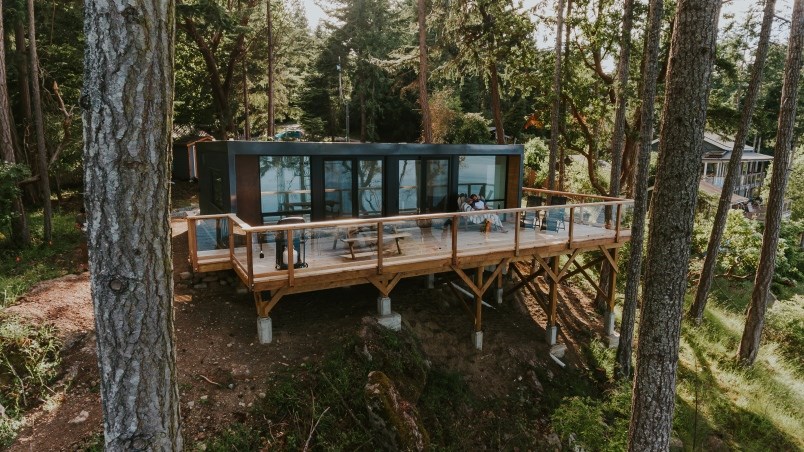Modular, recycled-shipping-container homes may be widely thought of as a practical and sustainable, but also temporary and often unattractive, living solution – perhaps best suited for housing short-term workers or transitioning homeless people into long-term housing.
But this myth is being gradually busted, as such homes can be beautiful as well as extremely long-lasting, according to modular home company Honomobo.
The firm’s co-founder Daniel Engelman told Glacier Media in an interview, “It’s a new type of home, so there’s still sometimes that psychological mindset that it’s a shipping container, so it’s meant to be shipped, it’s a temporary thing. But our clients no longer come to us with that mindset – we’re past that. These homes are incredibly durable – they can last hundreds of years, as opposed to the less-sustainable, 100-year lifespan of a typical wood-frame home.”
Shipping-container homes represent a housing opportunity that’s just as real as any house or condo, says Engelman, with banks willing to offer mortgages, and CMHC backing them as certified steel-framed modular homes. And, although this has not happened yet, Engelman says it will also be possible to resell the homes and the land they sit on in the usual way on the MLS.

Honomobo is only five years old, and interest in the company blew up about four years ago when it hit local media headlines for its innovation and flexible range of home models, and the story got picked up by some top architectural magazines. “The interest from the public really hasn’t let up since then,” said Engelman.
The models range from the M-1 one-bedroom/one-module unit priced at $157,772 (not including land costs, consultation fees and construction fees) all the way up to the six-module/four-bedroom, 1,920-square-foot HO6 model, which has a base cost of $499,362. The M1 will be featured at the B.C. Home and Garden Show, along with a smaller studio unit that Engelman says is popular as a guest or office space.

There are a number of suppliers of shipping-container homes across North America, but Engelman says what makes Honomobo stand out is primarily the design. With the choice of one entire wall made up of glass, and two walls in the larger units, the homes look more like contemporary architecture than recycled shipping containers. And yet, says Engelman, the design of the home embraces its roots, with a “minimalism and authenticity” that he says is appropriate to the shipping container shell.
The glass wall also allows for indoor-outdoor living, and these huge windows can be upgraded to sliding doors – “which makes the homes live larger than they actually are,” says Engelman.

As well as being durable, modular homes are extremely sustainable. These particular homes are highly energy-efficient and run 100 per cent off electricity, so they can be carbon-neutral if the owner runs it off solar power or hooks up to a green hydro supply.
Although Honomobo is based out of Edmonton, most of its customers are in B.C. and the Western United States. Engelman said there tends to be two kinds of customers. The first are those who choose smaller one- and two-module units as laneway homes (known in the States as “accessory dwelling units” or ADUs) placed in urban environments. The second are those who own land, often in somewhat more remote or island locations, and want an easy-to-build home for that site, either as a permanent residence or a vacation property.
Of the first type, Engelman said that most of his customers are in California, in pricey cities such as San Francisco, or in areas close to Metro Vancouver. He said, “The smaller modules are often used by multi-generational families, where either the kids or the parents are moving into the ADU and the other part of the family is moving into the main house. It really helps with affordability and helps people stay in their neighbourhood, which in turn keeps neighbourhoods vibrant.”
Engelman added that he was disappointed Honomobo has not yet been able to do this in the City of Vancouver, which has the same affordability issues as cities like San Francisco. “The regulatory environment of Â鶹´«Ă˝Ół»is really difficult to get anything done, so it just hasn’t been possible for us yet, which is sad,” he said. “Instead we’ve done laneway homes in places such as Whistler, Squamish, and Port Coquitlam.”

Also being featured at the B.C. Home and Garden Show is Honomobo’s Honomobar, which is a bar made out of part of a shipping container. Engelman says this "fun side project" has been a hit in areas where it has been placed as a pop-up bar in public plazas and in restaurant patios, and has prompted customers to order them for their own backyards or mini-businesses.
The B.C. Home and Garden Show runs from February 19-23 at B.C. Place Stadium. For more information, go to



